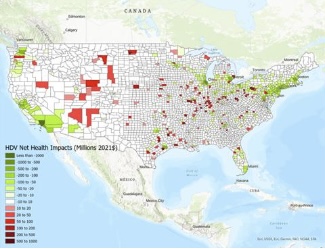ERC Explores Possibilities for Integrated Electric Vehicle Charging Infrastructure
Outcome/Accomplishment
The NSF-funded Engineering Research Center (ERC) Advancing Sustainability through Powered Infrastructure for Roadway Electrification (ASPIRE), headquartered at Utah State University, implemented a comprehensive study of the potential to seamlessly integrate charging facilities, power systems, and transportation infrastructure across the United States in anticipation of widespread electric vehicle transition.
Impact/Benefits
This research contributes to the development of an efficient and equitable electrified transportation system that will allow any and all vehicle users—from passenger vehicles to heavy-duty trucks—to access wireless and wired charging solutions that are seamlessly integrated into transportation systems and electric utilities throughout the United States.
Explanation/Background
The pioneering study launched by the NSF-funded Center evaluates charging systems for multiple classes of electric vehicles across the United States, assesses available transportation systems, and provides an environmental impact assessment of heavy-duty vehicle electrification.
Among the outcomes of the study was a determination that the market saturation rates for battery electric vehicles and plug-in electric vehicles are different according to location. The study also anticipated about $17.6 billion in health benefits from reduced pollution as a result of 100% heavy-duty vehicle electrification.
Location
Logan, Utahwebsite
Start Year
Energy and Sustainability
Energy, Sustainability, and Infrastructure
Lead Institution
Core Partners
Fact Sheet
Outcome/Accomplishment
The NSF-funded Engineering Research Center (ERC) Advancing Sustainability through Powered Infrastructure for Roadway Electrification (ASPIRE), headquartered at Utah State University, implemented a comprehensive study of the potential to seamlessly integrate charging facilities, power systems, and transportation infrastructure across the United States in anticipation of widespread electric vehicle transition.
Location
Logan, Utahwebsite
Start Year
Energy and Sustainability
Energy, Sustainability, and Infrastructure
Lead Institution
Core Partners
Fact Sheet
Impact/benefits
This research contributes to the development of an efficient and equitable electrified transportation system that will allow any and all vehicle users—from passenger vehicles to heavy-duty trucks—to access wireless and wired charging solutions that are seamlessly integrated into transportation systems and electric utilities throughout the United States.
Explanation/Background
The pioneering study launched by the NSF-funded Center evaluates charging systems for multiple classes of electric vehicles across the United States, assesses available transportation systems, and provides an environmental impact assessment of heavy-duty vehicle electrification.
Among the outcomes of the study was a determination that the market saturation rates for battery electric vehicles and plug-in electric vehicles are different according to location. The study also anticipated about $17.6 billion in health benefits from reduced pollution as a result of 100% heavy-duty vehicle electrification.

